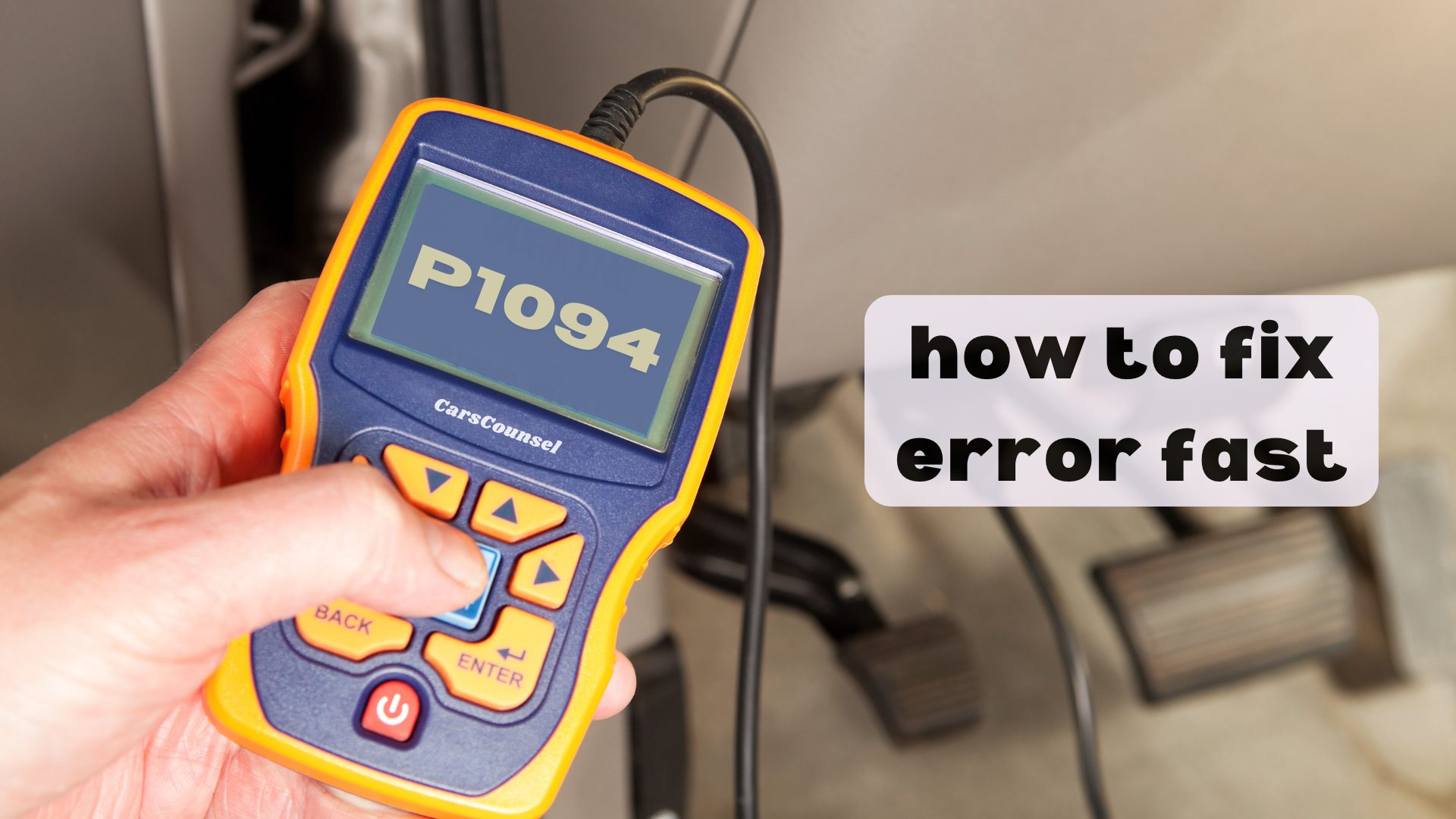Are you wondering if a faulty O2 sensor is really the culprit behind your car’s sluggish performance and poor fuel efficiency? The P1094 code suggests that the O2 sensor circuit in bank 2, sensor 1, is responding too slowly in the rich control range, but what’s causing this malfunction? Is it a wiring issue, a faulty component, or something more complex? As you investigate the possible causes, you’ll need to ponder the potential consequences of ignoring this error code, including further damage to your engine and costly repairs down the line.

Quick Navigation
Key Takeaways
- The P1094 code indicates a slow response in the rich control range of the O2 sensor circuit in bank 2, sensor 1, affecting engine performance.
- Faulty O2 sensors, wiring issues, and faulty engine control modules can trigger the P1094 code, disrupting fuel efficiency and emissions.
- Repair costs vary widely, ranging from $150 to $500 or more, depending on labour rates, parts, and diagnostic testing.
- Diagnosing the P1094 code requires sensor troubleshooting, wiring checks, rich control analysis, and fuel injector operation verification.
- Replacing the faulty O2 sensor involves disconnecting the battery, removing the old sensor, and installing a new one, ensuring proper connection and seating.
Code P1094 Description and Effects
Your vehicle’s engine control module (ECM) has triggered a P1094 code, indicating a problem with the O2 sensor circuit in bank 2, sensor 1.
This code signals a slow response in the rich control range, which affects sensor functionality and engine performance.
The O2 sensor’s primary function is to monitor oxygen levels in exhaust gases, providing feedback to the ECM.
This feedback is vital for adjusting the air-fuel mixture for peak combustion.
A slow response from the O2 sensor can lead to issues with fuel efficiency, emissions, and engine performance.
The ECM relies on accurate sensor data to make adjustments, so a faulty O2 sensor can significantly impact your vehicle’s overall performance.
Common Causes of the P1094 Code
Faulty components and electrical issues can trigger the P1094 code, disrupting the delicate balance of your vehicle’s engine performance.
Sensor failure rates are a common cause, with the O2 sensor in bank 2, sensor 1, being a prime suspect. Diagnosing wiring issues is also vital, as corroded or damaged wires can impede the sensor’s signal, leading to the code.
Additionally, a faulty engine control module (ECM) or its programming can also cause the issue. Clogged or faulty fuel injectors can affect the air-fuel mixture, triggering the code.
It’s essential to identify the root cause to prevent further damage and guarantee peak engine performance.
Repair Information and Costs
The repair costs for the P1094 code can vary widely, ranging from $150 to $500 or more, depending on the extent of the problem and the make and model of your vehicle.
You can expect to pay between $100 to $300 for a faulty sensor replacement, plus additional costs for diagnostic testing, parts, and labor.
- Labor rates: Varying rates depending on location and repair complexity.
- Parts costs: Replacing an O2 sensor can cost between $100 to $300.
- Diagnostic testing: Additional costs for testing to identify the root cause of the problem.
Some estimated costs to ponder:
Consult a trusted mechanic or auto repair shop for a more accurate estimate of your vehicle’s repair costs.
Diagnosing the P1094 Code Problem
Now that you’ve got a better understanding of the repair costs involved, it’s time to tackle the problem head-on by diagnosing the P1094 code issue.
To begin, you’ll need to perform sensor troubleshooting on the O2 sensor in bank 2, sensor 1.
Check the wiring and connectors for any signs of damage or corrosion.
Next, perform a rich control analysis to identify if the issue lies with the sensor’s response in the rich control range.
Use a scan tool to monitor the sensor’s output and compare it to the factory specifications.
If the sensor’s output is slow or erratic, it may indicate a faulty sensor.
Additionally, check the fuel injector operation and fuel pressure to rule out any other potential causes.
Replacing the Faulty O2 Sensor
With the diagnosis complete, you’re ready to replace the faulty O2 sensor in bank 2, sensor 1.
This vital step will help restore peak fuel efficiency and engine performance.
To guarantee a successful replacement, follow these key steps:
- Disconnect the battery to prevent any accidental engine starts or electrical shocks.
- Locate the faulty O2 sensor in bank 2, sensor 1, and remove it carefully to avoid damaging surrounding components.
- Install the new O2 sensor, verifying it’s securely connected and properly seated.
Proper sensor maintenance is essential for peak fuel efficiency and engine performance.
Additional Repair Resources Available
You’ve replaced the faulty O2 sensor, but that’s just the beginning.
Now it’s time to investigate additional repair resources available to guarantee a thorough fix.
For O2 sensor troubleshooting, consult factory service manuals for detailed guidance.
Find a reputable repair shop in your area to diagnose the P1094 code, and read reviews to verify you’re in good hands.
If you’re dealing with a specific make like BMW, MINI, or Subaru, access make-specific information on the P1094 code.
Visit Engine-Codes.com for a comprehensive resource on engine codes, including the P1094 code.
With these resources, you’ll be well-equipped to tackle the repair and get your vehicle running smoothly again.
Importance and Difficulty of Repair
Three key aspects to ponder when tackling a P1094 code repair are its importance, difficulty, and potential impact on your vehicle’s performance.
Understanding these factors will help you plan your repair strategy and allocate resources effectively.
1. Repair importance: The P1094 code is highly important, indicating that it can significantly affect your vehicle’s fuel efficiency, emissions, and engine performance.
Ignoring this code can lead to further damage and costly repairs down the line.
2. Repair difficulty: With a moderate difficulty level, you may need professional help or specialized tools to diagnose and fix the issue.
Weigh consulting a trusted mechanic or auto repair shop for assistance.
3. Repair timelines and shop recommendations: Depending on the complexity of the issue and the shop’s workload, be prepared to allocate several hours or even days for the repair.
Research local shops with experience in repairing P1094 codes to guarantee a timely and cost-effective fix.
Code Details and Specifications
Frequently, when dealing with a P1094 code, it’s essential to probe into the specifics of the code details and specifications to understand the issue at hand better.
You’ll want to know that the repair importance level is 3, indicating a high priority, and the repair difficulty level is 2, making it a moderate task.
The P1094 code affects fuel efficiency, emissions, and engine performance, so it’s pivotal to address it promptly.
The slow response in the rich control range bank 2 sensor 1 can be optimized with proper Sensor Maintenance, which is imperative for Performance Optimization.
More OBD-II Codes
Frequently Asked Questions
Can I Drive My Car With a P1094 Code?
You can drive your car with a P1094 code, but it’s not recommended as it may lead to poor engine performance, decreased fuel efficiency, and increased emissions. Guarantee safe operation by addressing the issue as soon as possible to avoid further damage.
Will a P1094 Code Cause My Car to Fail an Emissions Test?
A million things could go wrong, but let’s focus on the emissions test: with a P1094 code, your car’s slow O2 sensor response will likely fail emissions testing standards, as it can’t meet vehicle inspection procedures for ideal air-fuel mixtures.
How Often Should I Replace My O2 Sensor to Prevent P1094 Codes?
You should replace your O2 sensor every 50,000 to 70,000 miles as part of regular sensor maintenance to maintain peak fuel efficiency and prevent issues like slow response times that can trigger P1094 codes.
Can a Faulty O2 Sensor Cause Other Engine Codes to Appear?
You should know that a faulty oxygen sensor can trigger other engine codes, as sensor failure modes can affect overall engine performance, leading to additional issues, emphasizing the importance of regular oxygen sensor maintenance to prevent cascading problems.
Will Resetting the ECM Erase the P1094 Code Permanently?
When you reset the ECM, it won’t permanently erase the P1094 code; it’ll only temporarily clear it. For instance, if the issue stems from faulty sensor wiring, the code will reappear until you address the root cause, requiring a proper ECM calibration and repair.
Conclusion
You’ve finally reached the finish line in diagnosing and repairing the P1094 code. It’s been a marathon of troubleshooting and testing, but you’ve emerged victorious. Now, your engine is purring like a kitten, and your fuel efficiency is soaring through the roof! Don’t let a faulty O2 sensor hold you back – with the right tools and know-how, you can tackle this repair and get back on the road in no time.

